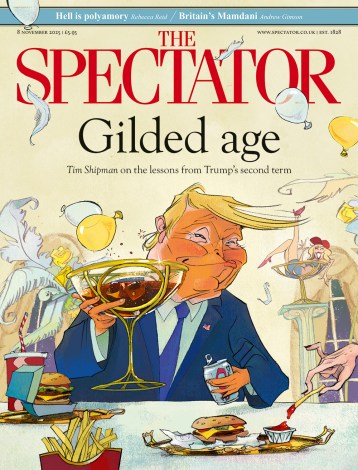W.S. Gilbert’s parody of Oscar Wilde, Reginald Bunthorne, wanted to make a minor scandal with his belief that ‘art stopped short in the cultivated court of the Empress Josephine’. In 1881 he was prophetic, although taste took at least 50 years to catch up. The English equivalent of Empire, the Regency period, has exerted a fascination that peaked in the period 1935–55, and has never completely faded. The Bunthornes of Bloomsbury in the 1980s, as noted by John Martin Robinson and Alexandra Artley in The New Georgian Handbook 20 years ago, were busy swagging their curtains, Egyptianising their cat flaps and faking ormolu in their reclaimed rooming houses.
Dr Robinson has now provided the book that would have been a compulsory accessory in those far-off days. The Regency Country House: From the Archives of Country Life (Aurum Press, £40) is a scholarly reappraisal of the period in which cheerfulness keeps breaking through. An exhibition of selected photographs from the book is showing at Sir John Soane’s Museum (until 25 February 2006), providing further fuel for what could become a new phase of Regency revival.
As the book reminds us, the Regency was a period when manners and lifestyle in Britain moved quickly towards many of the things we recognise in our own lives. The food was better. The rooms in country houses were comfortable and mostly less formal than before. Men and women enjoyed each other’s company more freely (very freely indeed in certain royal circles). Few periods were more socially mobile, and Dr Robinson draws on his expertise as Maltravers Herald Extraordinary to reveal what humble names and trades lay behind some noble titles of the time.
Both book and exhibition divide the houses by broad descending categories of grandeur. At Carlton House, Brighton Pavilion, Windsor and finally Buckingham Palace, the Prince Regent led taste in architecture and landscape design. By beginning his account in the 1790s, when George III suffered his first bouts of madness, rather than in 1811 when the Regency was officially declared, Dr Robinson begins with the death of Robert Adam and finishes when A.W.N. Pugin is waiting precociously in the wings. Industrialisation provided fortunes for vast building works, usually on the sites of previously existing houses. In the 1790s, the theory of the Picturesque was developed in writing and on the ground. With its responsiveness to the changing moods of nature, the variety of landscape conditions in Britain, and a newly opened eye for previously neglected pleasures, such as shaggy cows and cottages, the Picturesque set the tone for Regency inclusiveness. Thus the interiors at Windsor and Belvoir Castles could revive the style of Louis XIV within battlemented walls and towers. Nature came half indoors with conservatories, as at Broughton Hall. Dr Robinson ends his survey with the humblest Regency country houses, the cottages ornés, whose smartness lay precisely in their rather elaborate simplicity.
The houses of the Regency speak in many registers, from the coldest antique (Belsay Hall) to the hottest exotic (the Royal Pavilion). The Soane Museum, a microcosm of the same theatre of architectural emotion, is the perfect place in which to consider the significance of this body of work, while the photographs from Country Life are an endless plunge pool of delight, with their detail delineated on large plate negatives, or more recently in vivid colour.
Architecture in Britain at present shares a wild diversity with the Regency. Sensuality and austerity chase each other’s tails, and we even have a Prince of Wales adding to the national awareness of architecture, not always to the satisfaction of architects themselves. It seems as if there is a regular alternation between periods of unity and plurality, roughly every 50 years, so perhaps it is not surprising to find such conditions arising around the turn of a century. Historians of the future trying to understand our recent past will doubtless see it as the era of North Sea oil (now rapidly ending), equivalent to the era of easy money from coal mines and canals that funded so many Regency houses.
Theories of architecture usually attempt to justify more exclusive preferences, for classicism, Gothic or modernism, and at present we have little beyond the rather weak formulation of postmodernism to explain how variety could be anything other than a muddle. Does the Regency provide the answer? If one takes the view that a healthy natural ecology is achieved through the interaction of varied species operating in balance with each other, the idea of imposing uniformity in any area of life seems mistaken. Our current planning system, although basing its judgment of proposed buildings largely on their external appearance, usually fails to allow for variety, preferring the replication of something already existing. Perhaps it is time to issue planning committee members with extracts from Sir Uvedale Price on the Picturesque, and send this exhibition around the civic offices of England as an inspiration.





Comments